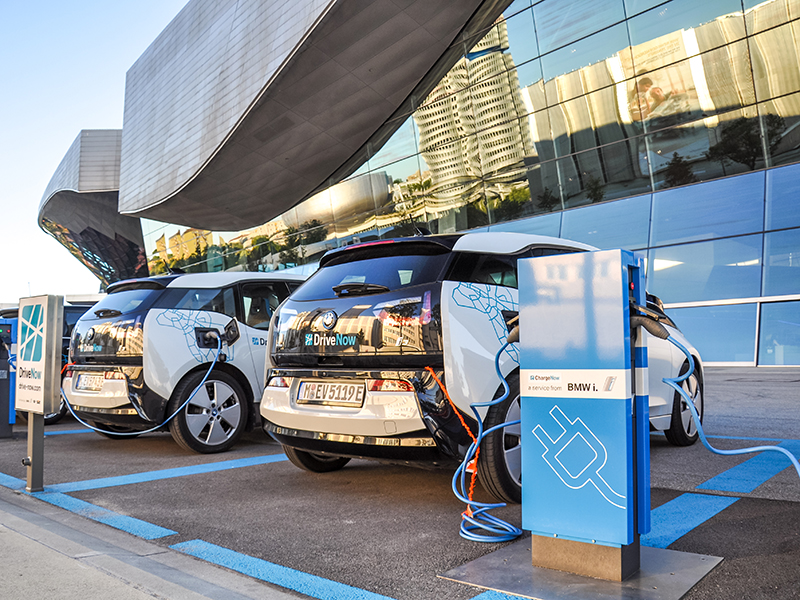
Customers craved for diversification, and the same is likely to hold true in the replacement of the combustion engine. Boris Liedtke looks at the future of our transportation system and argues that given our personal desire for individual solutions, the outcome is predestined to require us all to develop and accept the need for diversified transportation technologies.
After the incredible success of the combustion engine and its conquest of our way of life throughout the twentieth century, the technology has come under severe scrutiny as we enter the next millennium. During this unprecedented development, cities have been transformed from almost isolated islands of civilisation in a sea of natural wilderness to well oiled cogs in an ever more connected world. Asphalt roads cover not only endless amount of living space to attempt to smoothen our daily commutes by privately owned cars but also connect virtually every megacity, city, town, village or isolated dwelling in the civilised world. Nowadays in the U.S.A., over 86% of transportation is accounted for by passenger vehicles, motorcycles and trucks. The success of the combustion engine has made modern civilisation with all its comforts dependent on its existence and its logistic supply chains. There is no turning back from this historic earth shattering transformation of civilisation.
With this success came unprecedented new challenges. An objective glance at our modern cities today is sufficient to highlight the problems and limitations of the combustion engine. Humanity’s technological progress is based on the principle of escalation. As we invent technologies to solve problems, we give rise to new challenges. The more technology we have at our disposal, the more technology we require to deal with the consequences of our progress. Sophisticated food production has led us to face the challenges from overpopulation. Improvement in health care has caused us to face a financial under-provision for retirement funding. Man’s scientific evolution is less a linear progression of knowledge but rather a series of emergency measures to deal with the disastrous consequences of the previous cycle of inventions. We are self-condemned to the permanent rat race against the consequences of our own creativity. We progress but only towards an ever-larger need for progress. Yet to stop that progress or even to consider putting a halt to it is ultimately to doom humanity.
The combustion engine is no exception to this. We might not like the daily rush hour traffic, nor the pollution of diesel or other combustion engines, nor the smell of petrol stations in the middle of our cities, nor the resulting commercial dependency on the Middle East, but we simply cannot have the comfort and flexibility of our modern lives without the function that the present technology provides. As these “disastrous consequences” of our previous invention cycle increase, alternatives are emerging to deal with the fallout of our own creativity. As with the introduction of the combustion engine over 100 years ago, it is unclear into which direction technology and development will move next. Endless amount of corporate strategic planning, governmental and academic studies, external consultants are investing resources and brainpower into predicting what will come as the next technological replacement. The only thing certain is that the combustion engine as we know it today will be replaced by something else. To think otherwise and to desperately hold on to the past with its valuable patent rights and established logistic supply chains is to ultimately face doom. Businesses and enterprises associated with the combustion engine are stuck in the innovator’s dilemma. On the one hand they desire to maintain the status quo in order to ensure their competitive advantages of producing a highly-sophisticated machine as a source of value to their firm. At risk are tens of billions of dollars in intangible assets in the form of patents and production know-how as well as logistic supply chains to ensure the smooth manufacturing of the combustion engine. On the other hand, their governance and capital market dependency does not allow them to accept shrinking margins and high cash outflows associated with the market introduction of a new technology. Nevertheless for many firms, their very survival is at risk. To do nothing might be sufficient to ensure the survival of the present management but would inevitable endanger shareholder value, future employees and ultimately customers. Yet to invest in the wrong technology would only accelerate the financial doom.
The answer to what will replace the combustion engine will not go away by simply delaying the search for it. Political systems, customer behaviour, culture and regional market differences will ensure that the speed of change around the world will not be homogeneous.
One can already notice in certain Asian megacities that mobility has started to change radically. Daily mobility in Chinese cities is now supported by over 200 million electronic bicycles and scooters. Annual sales of these have been over 30 million for several years in China while the Western European market reaches barely 2 million and the American is even smaller with less than 200 thousand e-bikes sold in 2016. Western Europe’s strong environmental and social democratic culture has rekindled a political discussion favouring strong investment in public transportation and outright banning of certain combustion engines in inner cities. This is despite the fact that endless amount of academic studies as well as historic developments have shown that public transportation is not by itself a sufficient replacement of the personal desire for private individual freedom of transportation offered by the car. In the U.S.A., the distances and lack of financial investment in public transportation over decades simply means that solutions, like the e-bike, are not realistic alternatives without a fundamental change of customer behaviour. The very diversified starting point of the dominant markets for transportation will ensure that different approaches will be applied throughout the world in the foreseeable future. Similarly, political culture and willingness to adopt as well as vested interests in these markets ensures that the rate of change will differ from market to market. Centralised city states like Singapore are pushing ahead forcefully with e-car mobility and driverless technology while politicians in European democracies are still spending time sitting down to discuss acceptable levels of pollution for car manufacturers. This at a time when the American administration appears to have thrown out all environmental considerations in favour of a highly disruptive and protective commercial approach to its automobile industry, it would appear that, in Washington, politicians are more concerned with the challenge that something, anything gets produced in America rather than with the question what will global consumers and political voters accept as means of transportation to balance their desire for individual mobility vs. environmental considerations.
Politicians might temporarily enjoy the luxury of being able to take their countries down their desired road, at their desired speed into new and different technologies of transportation all at the whims of their electorate. On the other hand, global manufactures of automobiles and their suppliers need to face up to a much greater level of uncertainty. The momentum in progress of technology such as the speed of battery charging (reduction in “charging anxiety”) and increase in range of e-powered cars (reduction in “range anxiety”) will be unpredictable. Similarly the very direction of the advancement in technology is uncertain for vehicles; be they battery driven e-cars, fuel cells generating electricity for cars, solar panels and even wind powered ocean going oil tankers. Yet it is not only the direction and speed of technological changes that create uncertainty in the global automobile industry, it is also the direction and speed with which regulations under the various political systems will force or allow change. As a start-up or a purely regional player, the business model can be adopted much easier to the prevailing political, technological and customer directions. For the existing global automobile behemoths, this poses an almost insurmountable challenge. After years of consolidation to ensure cost control and acceptable product margins driven by globalised efficiency in a world accustomed to free trade, the automobile industry has become concentrated at a time when economic models, the rebirth of nationalism and technological uncertainty all favour adaptability to change within a selected market. In this environment for management of a large automobile firm to bet on a single technology will not only be unwise from a risk-return analysis but will ensure failure in a number of diversified markets just to achieve a potential success in one of them. There would appear only two sensible strategic paths forward to avoid becoming an industrial dinosaur focussed purely on the manufacturing of the combustion engine – the last “buggy whip” producer. Either breaking up the global company into regional firms and possibly along technological lines to face this uncertainty or alternatively, to reallocate corporate resources along a diversified and broad range reflecting different markets and the necessity to face diversified transportation technologies in the future.
Therein lies potentially the silver lining for the industry. What if the future does not hold a single technology to replace the combustion engine but instead allows the consumers what they have been previously craving for in many other markets – choice through diversification. Henry Ford’s sarcastic comment, “Any customer can have a car painted any colour that he wants so long as it is black,” is not the basis of a successful corporate strategy. Customers craved for diversification and not just in colour. The same is likely to hold true in the replacement of the combustion engine. Customers might only be satisfied if they can cover the short city distances with e-bikes and e-scooters; then switch to public transportation or shared electronic smart car sized vehicles. When planning for their weekend drive with the family through the countryside, they might opt for the hybrid-driven vehicle until they have learned to overcome their range and charging anxieties through a fuel cell powered electric car. In the meantime, their online purchased goods will be shipped across the ocean in wind-assisted cargo ships, then loaded onto large diesel-powered lorries to be delivered to centralised warehouses where smaller e-lorries transport their goods through the city with zero CO2 emission in places where people live. We might not know the exact timing or direction of the changes in each or any of the regions but given our personal desire for individual solutions, the outcome is predestined to require us all to develop and accept the need for diversified transportation technologies.
[/ms-protect-content]
About the Author
 Dr Boris N. Liedtke is the Distinguished Executive Fellow at INSEAD Emerging Markets Institute and has over twenty years experience in the financial sector. He was the CEO of the largest bank by assets in Luxembourg and board member for Operations at the largest German fund manager. He is author of numerous articles on finance and trade as well as having received his PhD from the London School of Economics for the publication of Embracing a Dictatorship by MacMillan.
Dr Boris N. Liedtke is the Distinguished Executive Fellow at INSEAD Emerging Markets Institute and has over twenty years experience in the financial sector. He was the CEO of the largest bank by assets in Luxembourg and board member for Operations at the largest German fund manager. He is author of numerous articles on finance and trade as well as having received his PhD from the London School of Economics for the publication of Embracing a Dictatorship by MacMillan.



































